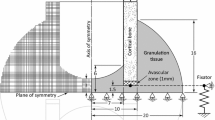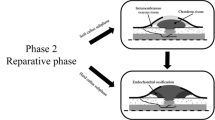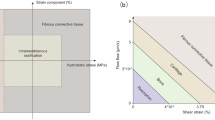Abstract
In bone fracture healing, new tissue gradually forms, ossifies, and eventually remodels itself to restore mechanical stiffness and strength across injury site. Mechanical strain at the fracture site has been implicated in controlling the process of healing and numerical mechanoregulation models with strain-based fuzzy logic rules have been applied to simulate bone healing for simple fracture geometries. However, many of these simplified models cannot capture in vivo observations such as delays in healing with torsional instability or differences in healing rate between different fracture types. Accordingly, the purpose of this work was to apply a fuzzy logic mechanoregulation fracture healing simulation technique to 3D models representing a range of clinically inspired fracture geometries with intramedullary nail fixation and multiaxial loading conditions. The models predicted that the rate of healing depends on the geometry of the fracture and that all fracture types experience a small healing delay with torsional instability. The results also indicated that when realistic torsional loading and fixator mechanics are included, previously published strain-based rules for tissue destruction lead to simulated nonunions that would not be expected in vivo. This suggested that fracture healing may be more robust to distortional strain than has been previously reported and that fuzzy logic models may require parameter tuning to correctly capture clinically relevant healing. The strengths of this study are that it includes fracture morphology effects, realistic implant mechanics, and an exploratory adaptation of the upper distortional strain threshold. These findings may help future researchers extend these methods into clinical fracture healing prediction.










Similar content being viewed by others
References
Ament C, Hofer EP (2000) A fuzzy logic model of fracture healing. J Biomech 33(8):961–968
Antonova E, Le TK, Burge R, Mershon J (2013) Tibia shaft fractures: costly burden of nonunions. BMC Musculoskelet Disorders 14(1):42
Attal R, Maestri V, Doshi HK, Onder U, Smekal V, Blauth M, Schmoelz W (2014) The influence of distal locking on the need for fibular plating in intramedullary nailing of distal metaphyseal tibiofibular fractures. Bone Joint J 96(3):385–389
Augat P, Burger J, Schorlemmer S, Henke T, Peraus M, Claes L (2003) Shear movement at the fracture site delays healing in a diaphyseal fracture model. J Orthop Res 21(6):1011–1017
Augat P, Claes L, Eckert-Hübner K (2002) The effect of mechanical stability on local vascularization and tissue differentiation in callus healing. J Orthop Res 20(5):1099–1105
Bishop JA, Palanca AA, Bellino MJ, Lowenberg DW (2012) Assessment of Compromised Fracture Healing. J Am Acad Orthop Surg 20(5):273–282
Bishop N, Rhijn M, Tami I, Corveleijn R, Schneider E, Ito K (2006) Shear does not necessarily inhibit bone healing. Clin Orthop Relat Res 443:307–14
Bottlang M, Lesser M, Koerber J, Doornink J, Rechenberg B, Augat P, Fitzpatrick D, Madey S, Marsh J (2010) Far cortical locking can improve healing of fractures stabilized with locking plates. J Bone Joint Surg Am 92:1652–60
Bottlang M, Tsai S, Bliven EK, Von Rechenberg B, Klein K, Augat P, Henschel J, Fitzpatrick DC, Madey SM (2016) Dynamic stabilization with active locking plates delivers faster, stronger, and more symmetric fracture-healing. J Bone Joint Surg Am 98(6):466–474
Bucholz RW, Heckman JD, Court-Brown CM, Tornetta P III (2002) Rockwood and Green’s fractures in adults, 5th edn. In: LWW
Carter D, Hayes W (1977) The compressive behavior of bone as two phase porous structure. J Bone Joint Surg Am 59:954–62
Chen G, Niemeyer F, Wehner T, Simon U, Schuetz M, Pearcy M, Claes L (2009) Simulation of the nutrient supply in fracture healing. J Biomech 42:2575–83
Claes L, Augat P, Suger G, Wilke HJ (1997) Influence of size and stability of the osteotomy gap on the success of fracture healing. J Orthop Res 15(4):577–584
Claes LE, Heigele CA (1999) Magnitudes of local stress and strain along bony surfaces predict the course and type of fracture healing. J Biomech 32(3):255–266
Comiskey D, MacDonald BJ, McCartney WT, Synnott K, O’Byrne J (2013) Predicting the external formation of callus tissues in oblique bone fractures: Idealised and clinical case studies. Biomech Model Mechanobiol 12(6):1277–1282
Dailey H, Daly C, Galbraith J, Harty J (2013) The Flexible Axial Stimulation (FAST) intramedullary nail provides interfragmentary micromotion and enhanced torsional stability. Clin Biomech (Bristol, Avon) 28(5):579–585
Dailey H, Schwarzenberg P, Daly C, Boran S, Maher M, Harty J (2019) Virtual mechanical testing based on low-dose computed tomography scans for tibial fracture: a pilot study of prediction of time to union and comparison with subjective outcomes scoring. J Bone Joint Surg Am 101:1193–1202
Dailey HL, Ph D, Daly CJ, Glass-hardenbergh A (2015) Mechanical origins of fracture nonunion: implant tests and finite element models of callus strains. In: Biomedical Engineering Society annual meeting
Dailey HL, Wu KA, Wu P-S, McQueen MM, Court-Brown CM (2018) Tibial fracture nonunion and time to healing after reamed intramedullary nailing. J Orthop Trauma 32(7):e263–e269
Doblaré M, García J, Gómez-Benito MJ (2004) Modelling bone tissue fracture and healing: a review. Eng Fract Mech 71:1809–1840
Duda G, Eckert-Hübner K, Sokiranski R, Kreutner A, Miller R, Claes L (1998) Analysis of inter-fragmentary movement as a function of musculoskeletal loading conditions in sheep. J Biomech 31:201–10
Epari DR, Kassi JP, Schell H, Duda GN (2007) Timely fracture-healing requires optimization of axial fixation stability. J Bone Joint Surg Am 89(7):1575–1585
Fong K, Truong V, Foote CJ, Petrisor B, Williams D, Ristevski B, Sprague S, Bhandari M (2013) Predictors of nonunion and reoperation in patients with fractures of the tibia: an observational study. BMC Musculoskelet Disorders 14(103):1–9
Geris L, Gerisch A, Vander Sloten J, Weiner R, Oosterwyck H (2008) Angiogenesis in bone fracture healing: a bioregulatory model. J Theor Biol 251:137–58
Gómez-Benito MJ, Garcia Aznar JM, Kuiper J, Doblaré M (2006) A 3d computational simulation of fracture callus formation: influence of the stiffness of the external fixator. J Biomech Eng 128:290–9
Höntzsch D, Schaser K-D, Hofmann GO, Pohlemann T, Hem ES, Rothenbach E, Krettek C, Attal R (2014) Evaluation of the effectiveness of the angular stable locking system in patients with distal tibial fractures treated with intramedullary nailing. J Bone Joint Surg Am 96(22):1889–1897
Inderchand M, Liu Y, Epari D, Roschger P, Schell H, Fratzl P, Duda G (2009) Spatial and temporal variations of mechanical properties and mineral content of the external callus during bone healing. Bone 45:185–92
Isaksson H (2012) Recent advances in mechanobiological modeling of bone regeneration. Mech Res Commun 42:22–31
Isaksson H, van Donkelaar CC, Huiskes R, Ito K (2006) Corroboration of mechanoregulatory algorithms for tissue differentiation during fracture healing: comparison with in vivo results. J Orthop Res 24(5):898–907
Kaspar K, Schell H, Seebeck P, Thompson MS, Schütz M, Haas NP, Duda GN (2005) Angle stable locking reduces interfragmentary movements and promotes healing after unreamed nailing: Study of a displaced osteotomy model in sheep tibiae. J Bone Joint Surg Am 87(9I):2028–2037
Kellam JF, Meinberg EG, Agel J, Karam MD, Roberts CS (2018) Introduction. J Orthop Trauma 32(1):S1–S10
Lacroix D, Prendergast PJ (2002) A mechano-regulation model for tissue differentiation during fracture healing: analysis of gap size and loading. J Biomech 35(9):1163–1171
MacKenzie EJ, Morris JA, Jurkovich GJ, Yasui Y, Cushing BM, Burgess AR, DeLateur BJ, McAndrew MP, Swiontkowski MF (1998) Return to work following injury: the role of economic, social, and job-related factors. Am J Public Health 88(11):1630–1637
Marsell R, Einhorn T (2011) The biology of fracture healing. Injury 42:551–5
O’Halloran K, Coale M, Costales T, Zerhusen T, Castillo RC, Nascone JW, O’Toole RV (2016) Will my tibial fracture heal? Predicting nonunion at the time of definitive fixation based on commonly available variables. Clin Orthop Relat Res 474(6):1385–1395
Pietsch M, Niemeyer F, Simon U, Ignatius A, Urban K (2018) Modelling the fracture-healing process as a moving-interface problem using an interface-capturing approach. Comput Methods Biomech Biomed Eng 21:1–9
Prendergast P, Huiskes R, Søballe K (1997) Biophysical stimuli on cells during tissue differentiation at implant interfaces. J Biomech 30(6):539–548
Rhinelander FW (1974) Tibial blood supply in relation to fracture healing. Clin Orthop Relat Res 105(1):34–81
Ribeiro F, Gomez-Benito MJ, Folgado J, Fernandes P, Garcia Aznar JM (2015) In silico mechano-chemical model of bone healing for the regeneration of critical defects: the effect of bmp-2. PLoS ONE 10:e0127722
Schell H, Epari DR, Kassi JP, Bragulla H, Bail HJ, Duda GN (2005) The course of bone healing is influenced by the initial shear fixation stability. J Orthop Res 23(5):1022–1028
Schwarzenberg P, Maher M, Harty J, Dailey H (2019) Virtual structural analysis of tibial fracture healing from low-dose clinical CT scans. J Biomech 83:49–56
Shefelbine SJ, Augat P, Claes L, Simon U (2005) Trabecular bone fracture healing simulation with finite element analysis and fuzzy logic. J Biomech 38(12):2440–2450
Simon U, Augat P, Utz M, Claes L (2011) A numerical model of the fracture healing process that describes tissue development and revascularisation. Comput Methods Biomech Biomed Eng 14(1):79–93
Steiner M, Claes L, Ignatius A, Niemeyer F, Simon U, Wehner T (2013) Prediction of fracture healing under axial loading, shear loading and bending is possible using distortional and dilatational strains as determining mechanical stimuli. J R Soc Interface 10(86):1–12
Steiner M, Claes L, Ignatius A, Simon U, Wehner T (2014a) Disadvantages of interfragmentary shear on fracture healing—mechanical insights through numerical simulation. J Orthop Res 32(7):865–872
Steiner M, Claes L, Ignatius A, Simon U, Wehner T (2014b) Numerical simulation of callus healing for optimization of fracture fixation stiffness. PLoS ONE 9(7):1–11
Tay W-H, de Steiger R, Richardson M, Gruen R, Balogh ZJ (2014) Health outcomes of delayed union and nonunion of femoral and tibial shaft fractures. Injury 45(10):1653–1658
Wähnert D, Gehweiler D (2017) Complications of intramedullary nailing-evolution of treatment. Injury 48S:S59–S63
Wang M, Yang N (2018) Three-dimensional computational model simulating the fracture healing process with both biphasic poroelastic finite element analysis and fuzzy logic control. Sci Rep 8:1–13
Wehner T, Claes L, Niemeyer F, Nolte D, Simon U (2010) Influence of the fixation stability on the healing time—a numerical study of a patient-specific fracture healing process. Clin Biomech (Bristol, Avon) 25:606–12
Wehner T, Steiner M, Ignatius A, Claes L, Aegerter CM (2014) Prediction of the time course of callus stiffness as a function of mechanical parameters in experimental rat fracture healing studies–a numerical study. PLoS ONE 9(12):1–16
Wilson C, Schutz M, Epari D (2015) Effects of strain artefacts arising from a pre-defined callus domain in models of bone healing mechanobiology. Biomech Model Mechanobiol 14(5):1129–41
Funding
There are no funding sources to declare.
Author information
Authors and Affiliations
Corresponding author
Ethics declarations
Conflict of interest
The authors declare that they have no conflict of interest with the work contained in this manuscript. In keeping with ICCME guidelines and the adopted policy of the Orthopaedic Research Society, of which both authors are members, we make the following complete disclosure: TR - No conflicts. HLD - 3c/4/6 - OrthoXel, DAC (Cork, Ireland), 9 - Orthopaedic Research Society (ORS) International Section for Fracture Repair (ISFR) Communications Committee Chair.
Additional information
Publisher's Note
Springer Nature remains neutral with regard to jurisdictional claims in published maps and institutional affiliations.
Electronic supplementary material
Below is the link to the electronic supplementary material.
Rights and permissions
About this article
Cite this article
Ren, T., Dailey, H.L. Mechanoregulation modeling of bone healing in realistic fracture geometries. Biomech Model Mechanobiol 19, 2307–2322 (2020). https://doi.org/10.1007/s10237-020-01340-5
Received:
Accepted:
Published:
Issue Date:
DOI: https://doi.org/10.1007/s10237-020-01340-5




